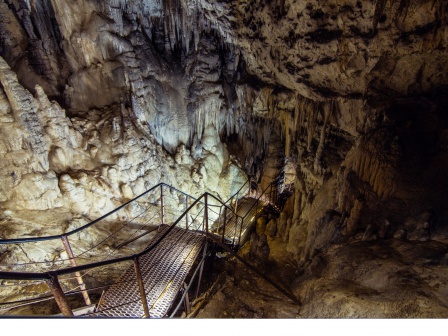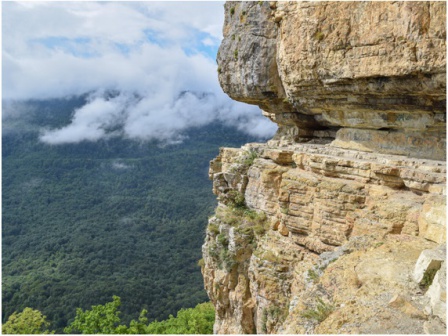Resource base
Climate
- The average annual precipitation is from 600 to 850 mm
- The best time of the year is August, September and October. During this period, the weather is sunny and warm, with little precipitation.
- The average annual atmospheric pressure in Apsheronsk is 743 mmHg, and the air humidity is 72%.
- During the year, the northeast wind prevails in Apsheronsk. The average wind speed during the year is 2.2 m/s.
Mineral
resources
Fresh water
reserves
- The water intake of Serebryachka river with a capacity of 1,050 thousand cubic meters per month
- Three wells located Tverskaya village have a combined capacity of 96,000 cubic meters per month
Fertile
lands
- One of the main focus areas is crop production, with an annual harvest of over 7,000 to 10,000 tons of grapes.
Recreational resources
- Guam Gorge
- Big Azish Cave
- Monk’s Cave and Monk’s Waterfall
- Eagle Shelf is a rocky ledge with an overhanging canopy naturally formed at a height of about 300–400 meters above the ground
- Three large deposits of mineral and medicinal waters

Guam Gorge
In the Apsheronsk district, nestled among ridges and mountain rivers, lies a remarkable natural marvel, the Guam Gorge. Referred to as ‘Guame’ in the Adyghe language, this location captivates with its stunning beauty and the peaceful coexistence of nature. This gorge, deep and narrow, has been sculpted by natural forces and is enclosed by towering steep cliffs, forming a truly majestic sight. The valley of the Kurdzhips river is located below.
Dense relict forests and rich animal life create a picturesque image of this place. Relatively gentle slopes of the gorge are replaced by steep, sometimes sheer walls, along which water flows from side tributaries, creating impressive waterfalls.
You can see a lot of different plants in the gorge. Along the Kurdzhips river, there are dense thickets of boxwood, which are common in the Apsheronsk district. Besides, you will find many relict plants that have maintained their original beauty since the Tertiary period, making the gorge truly unique. The favorable wind direction in this area shields these ancient plants from drastic climate changes. Above, there are redwood and yew trees, both ancient species that have remained unchanged for centuries. Oak, fir, and pine trees also grow here, blending together to create a distinct mix of forest scents that captivate every visitor. The air is rich in oxygen, and taking a stroll here is not only enjoyable but also beneficial for your health.

Big Azish Cave
The Big Azish Cave is situated in the southern, highest part of the Azish-Tau mountain range. The humidity and temperature in this location can fluctuate significantly, but typically, the temperature remains around 4–5 degrees. People with respiratory conditions such as sore throat, flu, or asthma often experience considerable relief when inside the cave, and frequent visits usually lead to recovery in most cases.
The entrance to the cavity is a vertical well, formed when a section of the upper hall’s roof caved in. The Azish treasury consists of several large halls and a lower floor gallery, through which an underground river runs.
The cave is 37 meters deep, covering an area of 1,900 square meters, with a total length of 690 meters. Only 220 meters are set up for sightseeing. Stalagmites and stalactites are found everywhere here. The stalagmites stand tall, resembling grand statues in Catholic churches, while the stalactites adorn both the ceiling and the walls.

Monk’s Cave and Monk’s Waterfall
Monk’s Cave and Monk’s Waterfall are situated in the Apsheronsk district within the Guam Gorge. The area where these natural features are found nearby is known as Monakhovo urochishche (tract).
Monk’s Cave is not extensively explored because it is mostly filled with water, leading to the halt of speleologists’ research when their aqualung air supply depleted. The cave features a large, scenic grotto. Legend has it that in the 16th century, a hermit monk resided in one of the nearby grottoes, using the healing water from the waterfall to cure people, which is how the cave got its name.
Monk’s waterfall originates in a cave, flowing out and cascading into a stunning waterhole surrounded by diverse forests. After a 100-meter journey, it plunges down in a 15-meter cascade. Over time, a small lake with crystal-clear water has formed in front of it. According to legend, attributed to the monk-healer, the water at this site retains its healing properties, making it a special experience to bathe in the basin of the Monk’s Falls!
From the observation platform near Monk’s Cave, you can have a great view of Guam Gorge. You’ll see the winding Kurdzhips river, the small railway that looks like a toy from up high, and the steep rocks, boxwood thickets, and sprawling yews that adorn the gorge. Nature generously bestows its beauty, captivating with a sense of timelessness.

Orlinaya polka (Eagle Shelf)
Eagle Shelf, a rock ledge with a natural overhanging canopy, sits approximately 300–400 meters above the ground. The ledge is around 5 meters wide and up to 3 meters high, positioned at an elevation of 1,000 meters above sea level. When viewed from a distance, the shelf resembles a lengthy tunnel carved into the rock by natural processes, with one side open and bordered by steep cliffs.
The rocks are named Eagle Rocks because large birds of prey, known as griffon vultures, which closely resemble eagles and have a wingspan of about 2 meters, nest there. They live above the ledge, and when you visit these locations, you can observe griffon vultures elegantly gliding through the air.
From here, you can enjoy panoramic views of Mezmay village, the Lagonak plateau, ridges, and the Kurdzhips river valley. The river flows from the Kurdzhips Gorge to the Guam Gorge, and you can see this entire stretch from Eagle Shelf as if it were in the palm of your hand.

Yuzhno-Khadyzhenskoye iodo-bromine water deposit (Mineral spa in the town of Khadyzhensk)
In 1959, the 730-bis well was drilled near the existing sanatorium to establish a reserve water supply. Currently, the hydromineral base of the balneological complex located on the territory of the sanatorium Mineralny in Khadyzhensk consists of 4 wells: 730, 730 bis, 730 bis-1, and 730 bis-2. The first wells (730, 730 bis) are in operation.



